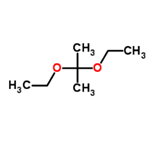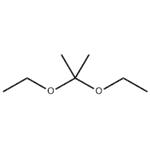Uses
Ethereal-camphorlike odor. Probably not used in flavors.Occasionally used in perfumes to introduce diffusive topnotes in herbaceous-camphoraceous blends (Lavandin-Rosemary, etc.).
Production Methods
2,2-Diethoxypropane can be produced by synthesis via orthoformic ester, or via vinyl ether, or via formiminoethylether hydrochloride.
Preparation
To a flask equipped as in Preparation 2-11 and containing 1725 gm (37.5 moles) of ethanol, 18.4 gm (0.058 mole) of mercuric acetate, and 28 ml of 26% boron fluoride etherate (26%) at 30°C is added dropwise over a 15 min period at 45-50°C, 1250 gm (12.5 moles) of isopropenyl acetate. After the reaction 2200 gm of 25% sodium hydroxide is added, the organic layer separated, washed first with 400 ml of 0.01 Ν sodium hydroxide, dried, and distilled to afford 1140 gm (69%), b.p. 110-113 C (760 mm Hg).

Safety Profile
Poison by intraperitoneal route.When heated to decomposition it emits acrid smoke.
Solubility in organics
Soluble in alcohol, miscible with CSS.oils
and perfume chemicals.





